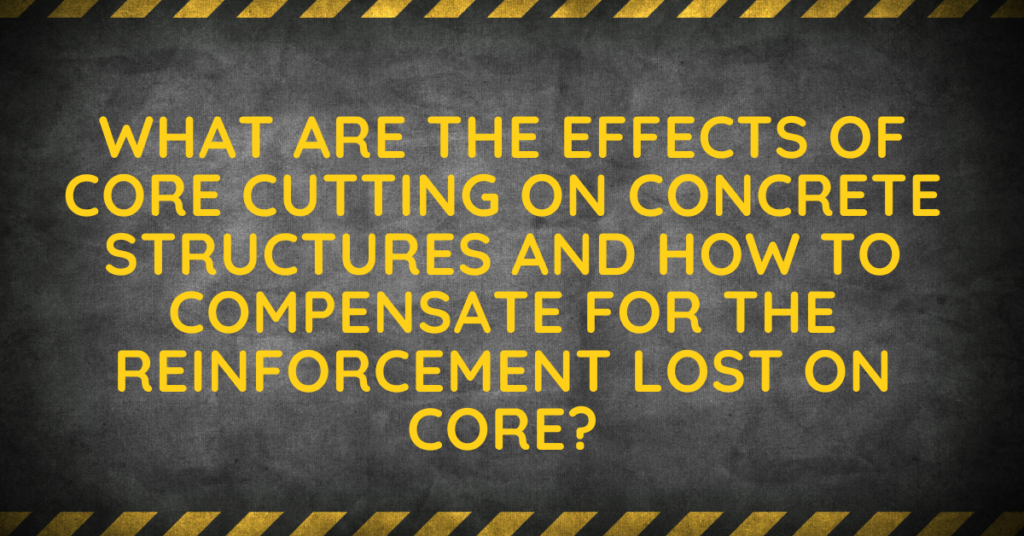Core cutting is a technique that is widely used in the construction industry. On the other hand, according to construction engineers and experts, when it comes to the adverse effects it causes on the structural integrity of the building, it must be banned from the industry. Now the question arises, What Are The Effects Of Core Cutting On Concrete Structures And How To Compensate For The Reinforcement Lost On Core?
Here is why this method should be discontinued and the reasons with remedies. By leaving an open space in the form of core cutting, you are cutting the rebars, considered the structures most functional element. This allows moisture and other elements to invade the concrete allowing the concrete to corrode. Talking about the basic concept of why we cover the beams and columns in the first place. They cause harm, and the experts in the industry do not recommend them as they are more harmful than useful.
The Remedies
Here are some of the remedies that need to be considered for avoiding structural damage. Add additional reinforcement to the structure. You can do that by bonding the steel plates or bars to their surrounding concrete. This can be done by using epoxy or other adhesives. There is another alternative that can be used for compensation, and that is using mechanical connectors. The second option consists of using Fiber-Reinforced Polymer (FRP). This material can be bonded to achieve additional reinforcement by binding it to the surrounding concrete. These materials are known for being lightweight and possess high strength.
How To Prevent Core Cuts
Here are some facts that will allow the users to prevent the core cuts in the first place. PVC sleeves, although old, are a perfect alternative. As they are cost-effective and are not considered labor-intensive. They can be molded and redesigned according to your specifications. Above all, they can fit into any design and shape of core cuts. Furthermore, if an opening is 9" in diameter, they are not considered an opening. And the 1″ diameter core cut causes multifold of damage.
FAQ: Effects of Core Cutting on Concrete Structures
Q1: What is core cutting in the context of concrete structures?
A1: Core cutting refers to the process of extracting cylindrical samples or cores from existing concrete structures. These cores are typically taken for various testing purposes, such as assessing the concrete’s quality, strength, durability, and investigating potential defects.
Q2: What are the potential effects of core cutting on the structural integrity of concrete elements?
A2: Core cutting, when performed correctly by experienced professionals, generally has minimal effects on the structural integrity of concrete elements. However, there may be some temporary localized weakening of the concrete around the drilled area. Properly executed core cutting should not compromise the overall stability or safety of the structure.
Q3: Can core cutting lead to concrete spalling or surface damage?
A3: Yes, if core cutting is not carried out carefully or if inadequate tools are used, it may cause concrete spalling or surface damage around the drilled hole. This can lead to aesthetic issues or create small areas of weakness in the concrete surface. It is crucial to employ skilled operators and appropriate equipment to minimize such risks.
Q4: Are there any potential risks to structural reinforcement during core cutting?
A4: Yes, there is a possibility of damaging the structural reinforcement like rebars when conducting core cutting. If the location of the reinforcement is not accurately identified before drilling, it could result in the cutting of rebar, which may weaken the structural element. Proper scanning and planning are necessary to avoid damaging reinforcement during the core cutting process.
Q5: Is it necessary to repair the drilled holes after core cutting is completed?
A5: Yes, it is essential to repair the drilled holes after core cutting. Leaving the holes unsealed can expose the concrete to moisture and other environmental factors, which might lead to deterioration and potentially compromise the structure’s integrity. Filling the holes with suitable repair materials ensures the structural soundness and longevity of the concrete element.
Please note that core cutting should always be carried out by trained professionals using appropriate equipment and techniques to minimize any negative impacts on the concrete structures. Regular inspections, maintenance, and repairs are vital to ensure the long-term performance and safety of concrete elements subjected to core cutting procedures.
